Posted: 12th April 2019 | Back to news feed
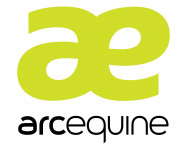
What is Laminitis?
Laminitis – inflammation of the lamina – is a disease that affects all members of the equine family. The wall of the hoof is composed of a tough and insensitive outer layer, known as the horn, which is connected to and supported by the internal, sensitive layer known as the lamina.
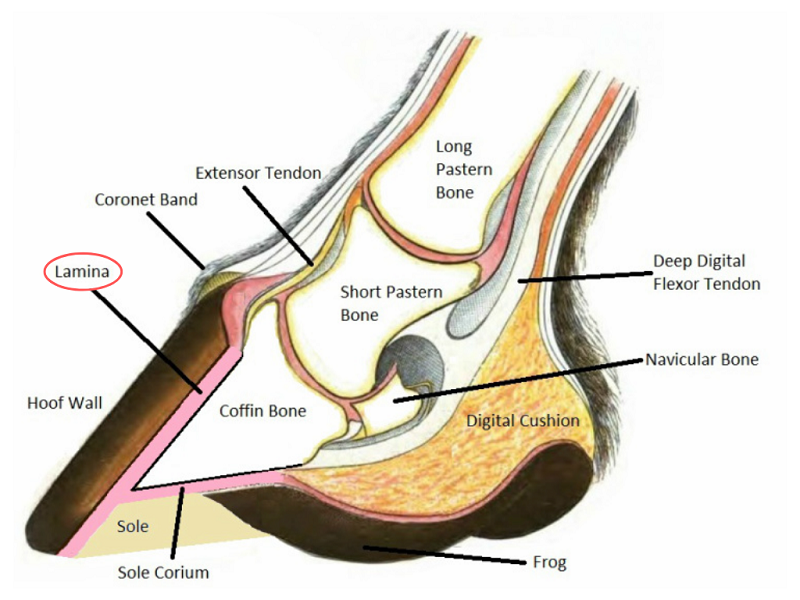
Source: Horse Health Simplified
When a horse contracts laminitis, blood circulation to the lamina is affected. This results in an inflammation of the miniscule lamina tissue tendrils that connect the interior of the hoof wall to the exterior of the coffin bone, which causes the tissues to swell and extreme pain.
In this inflamed state it doesn’t take long for the lamellae to begin to die due to lack of nutrient and oxygen-rich haemoglobin which further damages the cells.
Laura Petroski, B.V.M.S., a veterinarian at Kentucky Equine Research, says:
“Once the lamellae become inflamed, they are weakened and no longer able to suspend the coffin bone inside the hoof. If the horse tries to support its weight on the compromised limb, the hoof wall cannot hold the coffin bone in place, and devastating consequences ensue.”
Laminitis can develop in any of the feet, although it is more commonly observed in the front feet.
Causes of Laminitis
There are numerous different factors that are known to increase the chances of a horse developing laminitis, however, horses and ponies that are overweight, and those who have already suffered bouts of laminitis are particularly vulnerable.1
A study conducted by the BMC Veterinary Research Journal has assessed the causation of laminitis and related health factors. It found that the following factors were “likely to be present before a laminitis episode was reported”1:
Overweight horses are more than 2x as likely to develop laminitis2
- Laminitis was found to occur more frequently after a weight gain period, compared to if they had lost or simply maintained their weight.
Horses/ponies that are at an especially high risk of developing laminitis include those that2:
- have previously contracted laminitis, specifically those that were not promptly diagnosed by a vet.
- were part of the native Ireland/UK pony breeds.
- took a long time to recover from an episode.
- had periods longer than 8 weeks in-between regular hoof care.
Diet
Soluble carbohydrates such as sugars and starches can produce excess acidity in the gut which kills fibre digesting bacterium. Toxins released by the dying bacteria make their way into the bloodstream which compromises blood flow. A lack of healthy, nutrient & oxygen rich blood circulation in the feet is known to increase the chances of laminitis.3
Obesity
If horses receive more calories than they are likely to burn, they quickly put on weight. Feeding your horses may seem like a gesture of kindness, but in the long run, over feeding is causing serious harm.2
Surfaces
Trotting for extended periods of time on hard surfaces such as concrete or bitumen can have deleterious effects on the lamina, particularly in horses that have compromised hooves.3
Trauma
Traumatic laminitis is caused by repeated physical trauma to the feet during e.g. endurance riding, driving, or jumping on hard ground; it can also be caused by overenthusiastic hoof trimming. Severe lameness in one limb will cause a horse or pony to carry excessive weight on its other limbs, which may also cause laminitis.3
A study published in the Equine Veterinary Journal has found that laminitis is just as common as colic with 1 in 10 horses/ponies developing a laminitis episode every year. This year-round threat is an extremely painful disease. If it is not treated quickly in the correct way it can result in permanent damage, causing 15% of UK equine deaths per year.4
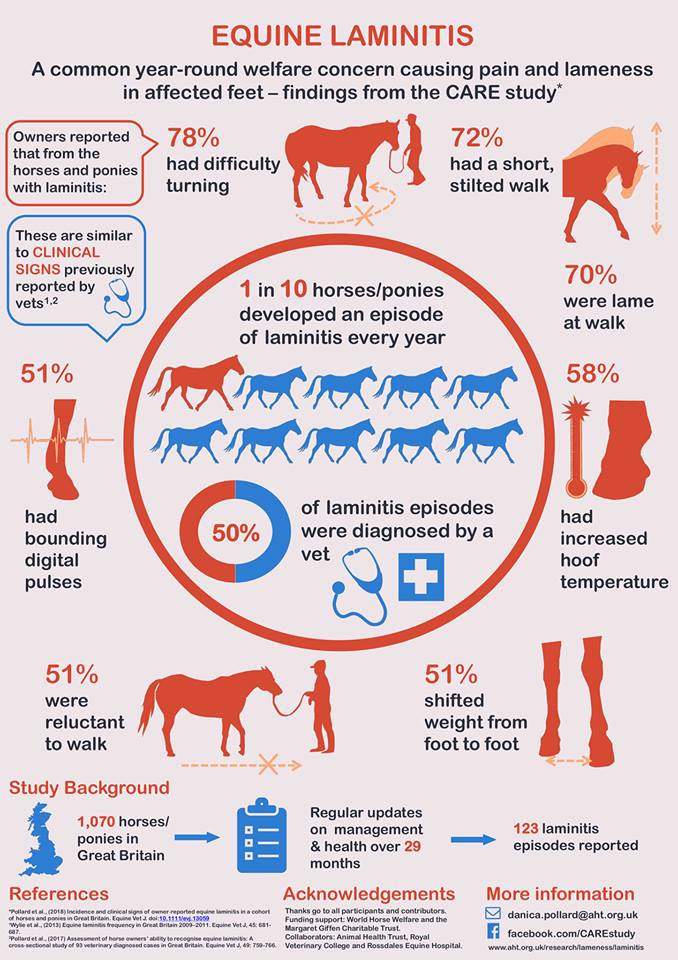
Signs of Laminitis
- Difficulty in turning
- A short/stilted gait
- Lameness at walk
- Increased hoof temperature
- Shifting weight from foot to foot
- Reluctance to walk
- Bounding digital pulse
Microcurrent Therapy
What is Microcurrent Therapy?
Microcurrent Therapy is used to facilitate the recovery of a wide range of acute and chronic conditions that would benefit from reduced inflammation, pain reduction, tissue repair and accelerated healing.5
Scientific research into Microcurrent Therapy has found that it facilitates the production of adenosine triphosphate (ATP). This is the energy providing molecule that is required for all metabolic cellular processes which are fundamental for facilitating pain management and the healing process.5

In essence, Microcurrent Therapy helps the cells produce ATP, which in turn, allows them to rapidly ‘regulate the inflammatory response,’ and consequently, the pain associated with laminitis.5
What Is the ArcEquine?
The ArcEquine is the smallest rechargeable wide-spectrum microcurrent device in the world. It’s a wearable, completely drug-free and non-invasive pain management and tissue repair system5 designed to assist with a multitude of equine conditions.
While the benefits of electrotherapy have been known about for over one hundred years, the technology to miniaturise these complex treatment protocols has only become available in recent years.
The ArcEquine is trusted by vets, equine chiropractors and physiotherapists.
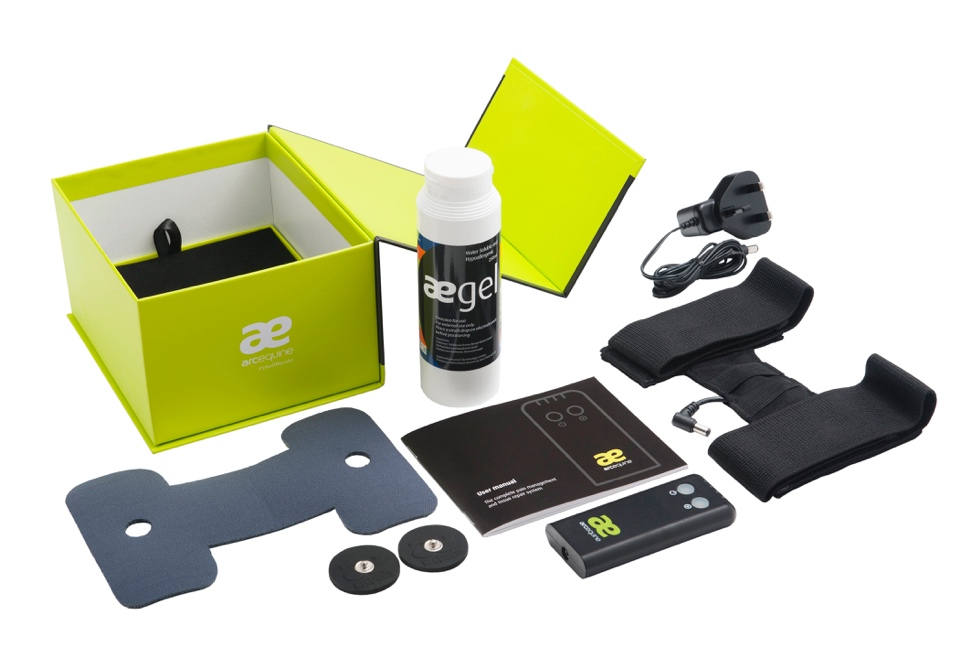
"We started using Arc Equine 2 years ago as part of our tendon management protocols. Since then I have seen many cases with better than expected quality and speed of healing. Maybe even more important, in combination with active rehabilitation, there is significantly less scar development as well. I see Arc Equine as a very welcome technology in the management of our equine athletes."
Henk Offereins
DVM, MVSc, MRCVS
Veterinary Director
Equinetendon.com
Can You Cure Laminitis?
Although there is no permanent ‘cure’ to laminitis, Microcurrent Therapy has an outstanding track record of reducing inflammation. As a complete pain management and tissue repair system, the ArcEquine Device facilitates healing to the point where inflammation is reduced to pre-laminitic levels.
Many Arc Users have utilised Microcurrent Therapy to help their horses defy the odds and successfully overcome their laminitis.
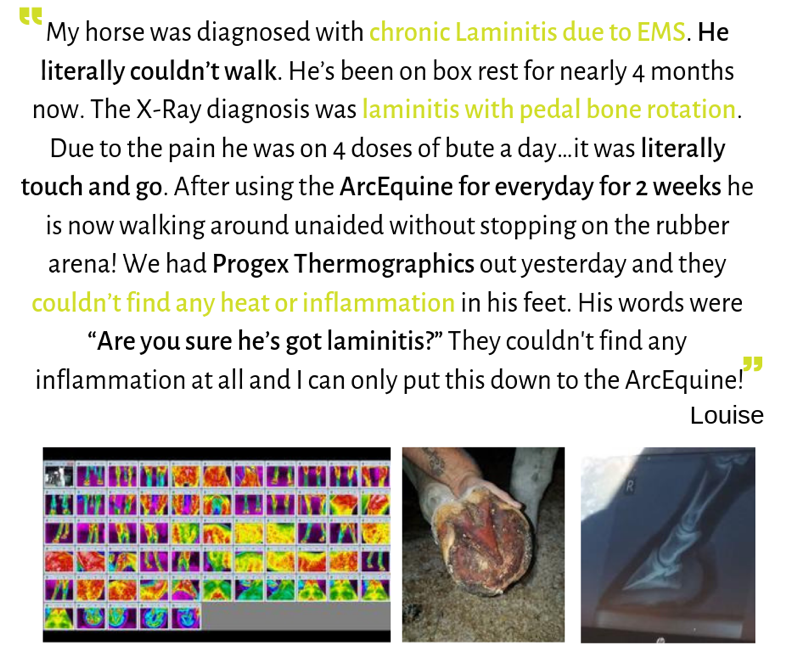
As with any new cutting-edge treatment, there is a delay between the early-adopters and the treatment becoming main-stream, but the tide is turning, and previous sceptics are now singing the praises of Microcurrent Therapy.
In fact, at ArcEquine, we have been getting more and more feedback from Arc users about how impressed their vets were at the speed of natural recovery and the lack of scaring left after injuries.
References:
1 Pollard, D., Wylie, C.E., Verheyen, K.L.P, and Newton, J.R. (2019) Identification of modifiable factors associated with owner-reported laminitis in Britain using a web-based cohort study approach. BMC Veterinary Research 15:59
2 Wylie, C.E., Collins, S.N., Verheyen, K.L, Newton, J.R., 201 3b. Risk factors for equine laminitis: a case-control study conducted in veterinary-registered horses and ponies in Great Britain between 2009 and 2011. Vet. J. 190. 57-69
3https://www.bluecross.org.uk/pet-advice/laminitis-horses
4 Pollard et al. (2018) Incidence and clinical signs of owner reported equine laminitis in a cohort of horses and ponies in Great Britain. Equine Vet Journal.
5 Watson T. Electrical Properties of Tissues. In: Watson T, editor. Electrotherapy: Evidence Based Practice. Edinburgh: Churchill Livingstone / Elsevier; 2008. p. 37-52.
6 Poltawski L, Watson T. Bioelectricity and microcurrent therapy for tissue healing - a narrative review. Physical Therapy Reviews. 2009;14(2):104-14.
The Equestrian Index newsfeed is compiled from articles submitted by advertising members and expresses the opinions of those members. Watsons Directories Ltd shall not be held liable for any inaccuracies or mis-statements therein.